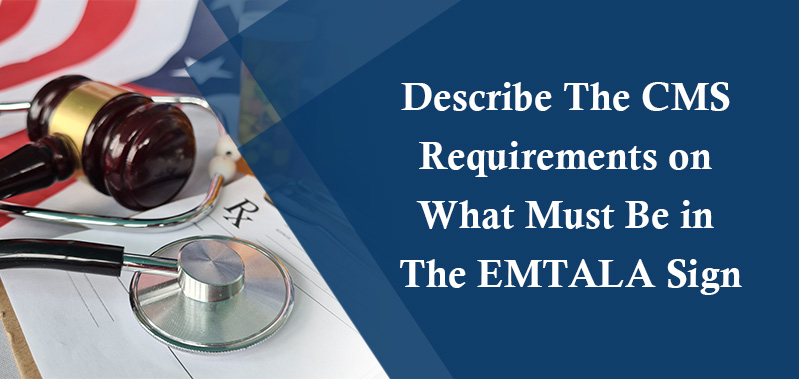
Describe The CMS Requirements on What Must Be in The EMTALA Sign
Few healthcare compliance updates of such magnitude exist as the Emergency Medical Treatment and Labor Act (EMTALA). Enacted into law in 1986, the law mandates that emergency medical treatment be offered to patients regardless of how much they can afford to pay. To effect this mandate, the Centers for Medicare & Medicaid Services (CMS) have issued some standards to hospitals, such as the posting of an EMTALA sign. The sign is an important communication tool, notifying patients of their rights and the hospital's responsibilities under the act. In this article, we will cover the CMS standards for the EMTALA sign, indicating what needs to be posted to remain in compliance and patient awareness.
The Significance of the EMTALA Sign
The EMTALA sign is not just a wall sign; it's a posting that a hospital wants to provide all care to people in emergency departments. The sign alerts patients, visitors, and hospital staff to the hospital's legal obligation under EMTALA. The CMS updates put some limitations on the EMTALA sign so that patients and others notice these responsibilities and rights. Violation of these conditions is punished with strict penalties, like fines and exclusion from Medicare reimbursement. Compliance and awareness of the CMS requirements of the EMTALA sign are essential to all healthcare centres.
Key Components of the EMTALA Signature
The EMTALA sign, according to the CMS guidelines, must have certain features that would facilitate compliance. They make it readable, understandable, and mindful. The following must be put on the EMTALA sign:
- Statement of Rights: The notice must clearly articulate that patients have the right to be offered a medical screening examination and stabilization services if they are in need thereof, even though they may be unable to pay. The statement of rights serves as the premise of the notice under EMTALA because it captures plain and straightforward words of the hospital's duty under the legislation.
- Sign Placement: The EMTALA sign must be highly conspicuous in certain areas of the hospital as per CMS. Such areas include the emergency department, admissions, and other areas where the patients are to be provided with emergency care. What is meant is to place the sign where it is highly conspicuous so that everyone who would potentially need emergency care will be able to see it.
- Language Accessibility: The EMTALA notice must be posted so that the patients will be able to read it in a language that everyone can understand. That is, do not employ medical jargon and use instead plain, simple language. Hospitals with patient populations whose areas are comprised primarily of individuals who are not English-speaking might have to post the notice in more than one language as well to make them accessible to all in their patient population.
- Contact Information: The notice should have contact information for reporting an EMTALA violation or complaint. This can be an administrator's or compliance officer's email address or phone number.
- Legibility and Visibility: It should be readable at the mean viewing distance. The sign should be placed at eye level to give maximum visibility. High contrast colour with bold lettering is advised so that the sign is easily visible.
Why Compliance Matters
The CMS regulations are not arbitrary but ensure patients, as well as neutrality standards of care, are protected. Displaying the EMTALA sign under the provisions of CMS ensures that the hospitals are abiding by neutral emergency care services. Knowing the 2025 Emtala Compliance Update prevents hospitals from unnecessary penalties and keeps them eligible for Medicare as well as Medicaid.
Although the EMTALA sign requirements are simple, some hospitals unintentionally fail to comply with the requirements. Some of the most common errors are putting the sign in a position that is not visible, putting it in a font that is too small, or failing to replace the sign when contact information has changed. To prevent these issues, hospitals must review their EMTALA signs regularly and ensure that they comply with all CMS requirements
Conclusion
The EMTALA sign is a straightforward but vital part of the health care system 2025 Emtala Compliance updates. It reminds whoever happens to walk through the door of the hospital's ethical and legal duty to treat all emergencies no matter their ability to pay. By adhering to the CMS regulations for posting the EMTALA sign, hospitals can not only stay out of trouble legally but also instil a culture of transparency and patient-centeredness. Whether you're a healthcare administrator, a compliance officer, or simply a concerned citizen, it's worth knowing the significance of the EMTALA sign. After all, the EMTALA sign isn't a sign; it's a commitment to put health and humanity first in every case.
Plain and simple, the CMS updates for the EMTALA sign are unequivocal. From the language of the rights to where and how it's displayed, it all counts. By being held accountable to these standards, hospitals are compelled to fulfil the intent of 2025 Emtala Compliance updates and guarantee that no one will ever be refused in their moment of need. The EMTALA sign is not just a government requirement; it is a glimmer of hope at the end of the tunnel and an indication of the values on which our healthcare system is built.




